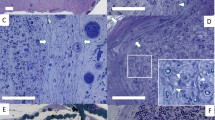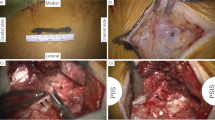Abstract
Background
Sacroiliac joint (SIJ)-related pain is associated with low back- and buttock pain and the SIJ score is diagnostically useful because it helps to differentiate between SIJ-related pain and pain due to other factors such as lumbar disc herniation and lumbar spinal canal stenosis. Middle cluneal nerve (MCN) entrapment (MCN-E) can produce pain involving the lower back and buttocks. Therefore, the origin of the pain must be identified. We successfully treated patients with a high SIJ score whose pain was attributable to MCN-E.
Methods
Between August 2016 and June 2017, we treated 40 patients with non-specific low back pain. Among them, 18 (45%) presented with a positive SIJ score. Although SIJ treatment was unsuccessful in 4 of these patients, they responded to MCN-E treatment.
Results
All 4 patients reported tenderness at the site of the sacrotuberous ligament (STL); 3 were positive for the one-finger test and experienced pain while sitting in a chair. The effect of SIJ block was inadequate in the 4 patients. As they reported severe pain at the trigger point in the area of the MCN, we performed MCN blockage. It resulted in pain control. However, in 1 patient, the effect of MCN block was transient and required MCN neurolysis. At the last visit, our patients’ symptoms were significantly improved; their average numerical rating scale score fell from 8.3 to 1.0, their Roland-Morris Disability Questionnaire score fell from 12.8 to 0.3, and their average Japanese Orthopaedic Association score rose from 12.5 to 19.5.
Conclusions
In patients with suspected SIJ-related pain, the presence of MCN-E must be considered when the effect of SIJ block is unsatisfactory.



Similar content being viewed by others
References
Aota Y (2016) Entrapment of middle cluneal nerves as an unknown cause of low back pain. World J Orthop 7:167–170
Bernard TN, Kirkaldy-Wills WH (1985) Recognizing specific characteristics of nonspecific low back pain. Clin Orthop Relat Res 217:266–280
Borowsky CD, Fagen G (2008) Sources of sacroiliac region pain: insights gained from a study comparing standard intra-articular injection with a technique combining intra- and peri-articular injection. Arch Phys Med Rehabil 89:2048–2056
Cusi M, Van der Wall H, Saunders J, Wong L, Pearson M, Fogelman I (2013) Sacroiliac steroid injections do not predict ablation relief - not a surprise. Pain Med 14(1):163–164
Fujiwara A, Kobayashi N, Saiki K, Kitagawa T, Tamai K, Saotome K (2003) Association of the Japanese Orthopaedic Association score with the Oswestry Disability Index, Roland-Morris Disability Questionnaire, and Short-Form 36. Spine. 28:1601–1607
Hjermstad MJ, Fayers PM, Haugen DF, Caraceni A, Hanks GW, Loge JH, Fainsinger R, Kaasa S (2011) Studies comparing Numerical Rating Scales, Verbal Rating Scales, and Visual Analogue Scales for assessment of pain intensity in adults: a systematic literature review. J Pain Symptom Manag 41:1073–1093
Isu T, Kim K, Morimoto D, Iwamoto N (2018) Superior and middle cluneal nerve entrapment as a cause of the low back pain - clinical review. Neurospine 15(1):25–32
Kim K, Isu T, Matsumoto J, Yamazaki K, Isobe M (2018) Low back pain due to middle cluneal nerve entrapment neuropathy. Eur Spine J 27:309–313
Konno T, Aota Y, Saito T, Qu N, Hayashi S, Kawata S, Itoh M (2017) Anatomical study of middle cluneal nerve entrapment. J Pain Res 10:1431–1435
Kurosawa D, Murakami E, Ozawa H, Koga H, Isu T, Chiba Y, Abe E, Unoki E, Musha Y, Ito K, Katoh S, Yamaguchi T (2017) A diagnostic scoring system for sacroiliac joint pain originating from the posterior ligament. Pain Med 18(2):228–238
Liliang PC, Lu K, Liang CL, Tsai YD, Wang KW, Chen HJ (2011) Sacroiliac joint pain after lumbar and lumbosacral fusion: findings using dual sacroiliac joint blocks. Pain Med 12:565–570
Luukkainen RK, Wennerstrand PV, Kautiainen HH, Sanila MT, Asikainen EL (2002) Efficacy of periarticular corticosteroid treatment of the sacroiliac joint in non-spondyloarthropathic patients with chronic low back pain in the region of the sacroiliac joint. Clin Exp Rheumatol 20:52–54
Maigne JY, Planchon CA (2005) Sacroiliac joint pain after lumbar fusion. A study with anesthetic blocks. Eur Spine J 14:654–658
Matsumoto J, Isu T, Kim K, Iwamoto N, Morimoto D, Isobe M (2018) Surgical treatment of middle cluneal nerve entrapment neuropathy - technical note. J Neurosurg Spine 29:208–213
McGrath MC, Zhang M (2005) Lateral branches of dorsal sacral nerve plexus and the long posterior sacroiliac ligament. Surg Radiol Anat 27:327–330
Murakami E, Kurosawa D, Aizawa T (2018) Treatment strategy for sacroiliac joint-related pain at or around the posterior superior iliac spine. Clin Neurol Neurosurg 165:43–46
Murakami E, Tanaka Y, Aizawa T, Ishizuka M, Kokubun S (2007) Effect of periarticular and intraarticular lidocaine injections for sacroiliac joint pain: prospective comparative study. J Orthop Sci 12(3):274–280
Sakamoto N, Yamashita T, Takebayashi T, Sekine M, Ishii S (2001) An electrophysiologic study of mechanoreceptors in the sacroiliac joint and adjacent tissues. Spine. 26:E468–E471
Schomacher M, Kunhardt O, Koeppen D, Moskopp D, Kienapfel H, Kroppenstedt S, Carbraja M (2015) Transient sacroiliac joint-related pain is a common problem following lumbar decompressive surgery without instrumentation. Clin Neurol Neurosurg 139:81–85
Standring S (2008) Gray’s anatomy. The anatomical basis of medicine and surgery, 38th edn. Churchill Livingstone, Edinburgh
Vanelderen P, Szadek K, Cohen SP, De Witte J, Lataster A, Patijn J, Mekhail N, van Kleef M, Van Zundert J (2010) Sacroiliac joint pain. Pain Pract 10(5):470–478
Vleeming A, Pool-Goudzwaard AL, Hammudoghlu D, Stoeckart R, Snijders CJ, Mens JM (1996) The function of the long dorsal sacroiliac ligament: its implication for understanding low back pain. Spine 21(5):556–562
Author information
Authors and Affiliations
Corresponding author
Ethics declarations
Conflict of interest
The authors declare that they have no conflict of interest.
Ethical approval
All procedures performed in this study were in accordance with the ethical standards of the institutional and/or national research committee and with the 1964 Helsinki declaration and its later amendments or comparable ethical standards.
Informed consent
Informed consent was obtained from all individual participants included in the study.
Additional information
Publisher’s note
Springer Nature remains neutral with regard to jurisdictional claims in published maps and institutional affiliations.
This article is part of the Topical Collection on Peripheral Nerves
Rights and permissions
About this article
Cite this article
Matsumoto, J., Isu, T., Kim, K. et al. Middle cluneal nerve entrapment mimics sacroiliac joint pain. Acta Neurochir 161, 657–661 (2019). https://doi.org/10.1007/s00701-019-03861-0
Received:
Accepted:
Published:
Issue Date:
DOI: https://doi.org/10.1007/s00701-019-03861-0




